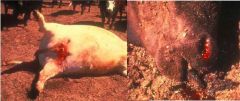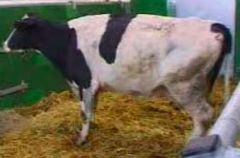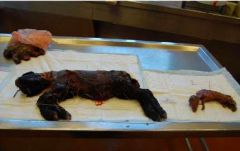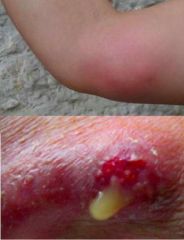![]()
![]()
![]()
Use LEFT and RIGHT arrow keys to navigate between flashcards;
Use UP and DOWN arrow keys to flip the card;
H to show hint;
A reads text to speech;
66 Cards in this Set
- Front
- Back
|
What are some of the benefits of WHO targeting information & services to women in many of the poorer countries??
|
Increased livestock production
Improved family nutrition and A decrease in the incidence of zoonotic diseases and diseases from foods of animal origin |
|
|
What are some of the positive effects & social benefits of Animal Health??
|
1) Healthy animals provide income, food, transport/draught, manure.
2) Quality & quantity of animal products is enhanced 3)Improved national herd health & QA = increased food security 4) economic development through national & international trade in animals & animal products |
|
|
What are zoonoses?
|
those diseases and infections that are naturally transmitted between vertebrate animals and man".
|
|
|
Define: Direct(ortho) zoonosis?
|
transmitted from an infected to a susceptible vertebrate host by direct contact, contact with a fomite or by a mechanical vector
|
|
|
Define: Cyclozoonosis?
|
These require more than one vertebrate host species (but no invertebrate) to complete the developmental cycle of the agent
|
|
|
Define: Metazoonosis
|
These are transmitted biologically by invertebrate vectors
|
|
|
Define: Saprozoonosis
|
These have both a vertebrate host and a non-‐animal developmental site/reservoir, such as food, soil or plants
|
|
|
define Anthropozoonosis
|
Anthropozoonosis: infections transmitted to humans from animals;
|
|
|
Define Zooanthroponosis
|
infections transmitted to animals from man;
|
|
|
Define: Amphixenosis
|
infections that are maintained by both man and animals and which may be transmitted in either direction.
|
|
|
Explain what a reservoir is in regard to Zoonosis?
|
Epidemiology:
– one or more epidemiologically connected populations or environments in which a pathogen can be permanently maintained and from which infection is transmitted to the defined target species • Lay terms – animate or inanimate sources which harbour disease-‐ causing organisms and thus serve as potential sources of disease outbreaks |
|
|
What effects may an outbreak of a Zoonosis have on animals & People?
|
Outbreaks can affect:
Human & Animal illness & or mortality. Massive animal culls International & national trade disruption/losses Food shortages Huge national & international economic impacts. |
|
|
An emerging disease (zoonosis) is defined as a new infection resulting from….
|
-the evolution or change of an existing pathogen or parasite resulting in a change of host range, vector, pathogenicity or strain or the occurrence of a previously unrecognised infection or disease.
|
|
|
Re-emerging diseases are??
Give an example? |
An already known disease (zoonosis) that either shifts its
geographical setting or expands its host range, or significantly increases its prevalence. Examples: Rift Valley Fever, Canine Rabies, MDR TB, Brucelosis, Cholera, Dengue |
|
|
Why are we getting emerging and re-‐ emerging organisms?
|
multifactorial:
Encroachment of humans into natural habitats • Human demographic • Economic development and changes in the use of land increasing demand for nutritional support – Changes in food processing and handling – Increased globalisation |
|
|
Under what circumstances should you call Biosecurity Queensland
on 13 25 23 or the Emergency Disease Watch Hotline 1800 675 888.?? |
If you suspect a notifiable disease, whether you are an owner, a vet, laboratory staff or anyone else, you must report it!!
|
|
|
Apart from suspicion of any of the Notifiable Diseases Name 4 other signs of disease you would immediately report?
|
a lot of ill or dead animals including birds or aquatic animals
* rapid spread of disease through a herd or flock * animals that are lame, drooling or salivating excessively * animals that have ulcers, erosions or blisters around the feet, muzzle, udder or teats and/or in the mouth * unusual nervous signs * profuse bloody diarrhoea * respiratory distress or persistent coughing in horses * deep smelly, fly struck wounds * any link to another country (any sheep recently back from Ibiza) * any unusual or unfamiliar disease in animals or birds. |
|
|
In Australia, who are the people most at risk of contracting zoonoses??
|
– vets
– farmers – abattoir workers – shearers – pet & companion animal owners |
|

This animal suffered from Fever, difficulty breathing, bloody discharges from nose, mouth & rectum prior to death. What disease do you suspect? is it notifiable? Is it Zoonotic?
|
Anthrax (Bacillus anthracis)
Yes Yes |
|

You are called to a cow that has Teat, interdigital, and oral (tongue & buccal surface) vesicles with fever. What are 2 possible diseases? are either notifiable??
|
Vesicular Stomatitis (Rhabdovirus)
Foot & Mouth Disease Both are notifiable |
|

What zoonotic agent could be implicated in this picture??
|
Toxoplasmosis
|
|

What zoonosis is this?
|
Sheep Ringworm
|
|

What could cause this human lesion?
|
Cutaneous Anthrax
|
|
|
Exports and imports of plants and animals (including products) may be subject to regulation under what legislation?
|
• Environment Protection and Biodiversity Conservation Act 1999
• Customs Act 1901 • Quarantine Act 1908 (AQIS) • Queensland: Nature Conservation Act 1992 |
|
|
Balantidium coli is a protoza that can infect humans, what is the main reservoir & what does it cause?
|
Pigs are the main reservoir, but rodents and non-‐human primates too
• Serious pathogen once host-‐ adapted (e.g. explosive diarrhoea every 20 minutes...) |
|
|
Name 3 important diseases that have been linked to Bats?
|
Lyssavirus (Rabies)
Hendra Nipah Virus |
|
|
Name 4 diseases that infect Dogs that can be transmitted to humans?
|
• Campylobacter (campylobacteriosis)
• Cryptosporidium (cryptosporidiosis) • Dipylidium (tapeworm) • Giardia (giardiasis) • Hookworm Infection • Leishmania infection (leishmaniasis) • Leptospira Infection (leptospirosis) • Lyme Disease: • Q Fever (Coxiella burnetii) • Rabies • Ringworm • Rocky Mountain Spotted Fever • Salmonella Infection (salmonellosis) • Tapeworm (flea tapeworm): See Dipylidium Infection • Toxocara Infection (toxocariasis, roundworm) |
|
|
Who is at higher risk of contracting Toxocara?
|
Children
Dog & Cat owners Anyone ingesting dirt (kids, unwashed fruit & veg etc) |
|
|
What measures can you take to prevent toxocariasis?
|
Hand washing after handling dirt (teach kids).
cover sandboxes to restrict animal access to play areas clean up & dispose of dog & cat faeces promptly & wash hands afterwards. Treat pets to prevent/treat infection with toxocara (worming pets). |
|
|
What larval migrans can occur in humans infected with toxocara?
|
Cutaneous
Visceral Neural Ocular |
|
|
What is Dipylidium & how can humans become infected?
|
Dog & Cat tapeworm
Humans (usually children) infected via ingestion of fleas. |
|
|
What are the Four rules for hydatid (Echinococcus granulosus) prevention that are taught?
|
Don’t feed dogs raw meat or offal – use commercial foods
– Don’t allow dogs to wander or be unsupervised where they might eat from a carcass – Practice (and teach) good personal hygiene – don’t kiss dogs, don’t let them lick you on the face, wash hands after touching dogs, don’t eat while playing with dogs – Worm at risk dogs with Praziquantel at least every 6 weeks. |
|
|
What is the causative agent in cat scratch disease? Name 2 ways to minimise risk?
|
Bartonella henselae
Avoid "rough play" with cats, especially kittens. Wash cat bites and scratches immediately and thoroughly with running water and soap. Do not allow cats to lick open wounds that you may have. |
|
|
What steps would you recommend to someone who was worried about contracting a zoonosis from their pet?
|
• Ensure parasite control – external and internal, pets ideally kept indoors, look for and remove ticks
• Pass obedience/training criteria • Strict hygiene, esp cleaning litter trays + personal hygiene esp handwashing • Vet visit every month for check + worming • Basic rules – eg. don’t kiss animals |
|
|
What would you recommend recommend to prevent toxoplasmosis?
|
Do not eat raw or undercooked meat. Meat should be cooked to a temperature of at least 70-‐71° for 20 minutes.
• Do not drink unpasteurized milk. • Do not eat unwashed fruits and vegetables. • Wash hands and food preparation surfaces with warm soapy water after handling raw meat. • Wear gloves when gardening. Wash hands after gardening. • Wash hands before eating (especially for children). • Keep children's sandboxes covered. • Do not drink water from the environment unless it is boiled. • Do not feed raw meat or undercooked meat to cats. Also, do not give them unpasteurized milk. • Do not allow cats to hunt or roam. • Do not allow cats to use a garden or children's play area as their litter box. • Remove faeces from the litter box daily and clean with boiling or scalding water. • Pregnant women, and persons with suppressed immune systems, should not clean the litter box. • Control rodent populations and other potential intermediate hosts. |
|
|
Define Veterinary Public Health?
|
The sum of all contributions to the physical, mental and social well being of humans through an understanding and application of veterinary science"
|
|
|
What are some of the consequences of the worlds rapidly growing population regarding animal health & production?
|
Increased demand for foods of animal origin.
increasing intensive systems of livestock & poultry production. Higher levels of production in warm, humid, disease prone areas. Increased globalisation & trade Increased spread of disease Challenges involving social customs, animal welfare & financial consequences |
|
|
What are 4 of the main aims of VPH?
|
• Surveillance, prevention, and control of zoonoses important to public health.
• Prevention of foodborne diseases -‐ safety of food for human consumption. • Promotion of animal health to boost production, productivity and thus, the food supply and socioeconomic development. • Promotion of environmental protection to prevent potential risks to public health stemming from livestock production and pet ownership. |
|

A wildlife carer in Tasmania developed these lesions, what disease is suspected & what animal carries it?
|
Tularaemia
Francisella tularensis Possums |
|

What do these images depict? Infection with what could cause these lesions?
|
Dermal larval migrans & Ocular larva migrans
Toxocara Infection (toxocariasis, roundworm) |
|
|
What is the main reservoir of Avian influenza?
|
Waterbirds
|
|
|
What are 3 main primary causes of poultry products spoilage??
|
Prolonged distribution or storage time, Inappropriate storage temperature, High initial bacterial counts,
High post-rigor meat pH |
|
|
What does TVC stand for (not Townsville Vet Clinic)!
What could cause a high TVC & what will the result of this be? |
Total viable count of bacteria (TVC)
A high TVC resulting from severe contamination during slaughter or processing will shorten the shelf-life even in ideal conditions. It also indicates poor hygiene so that contamination with food- poisoning bacteria is likely |
|
|
4 ways of controlling microbial growth?
|
Prevention of access of microbes (contamination / hygiene) – HACCP,SOPsetc,qualityofbrinesolutionetc
• Refrigeration • Heating / cooking • Physically remove agent: centrifugation, trimming, washing, filtering • Low pH – organic acids; pickling (fermenting in brine or storing in acetic acid for example), brining, corning • Irradiation (γ – radiation) • Aw – water availability • Modified atmospheres: red meat needs high oxygen to maintain the red colour, bread requires low oxygen to avoid mould and vegetables often need a three-gas mixture (MAP – Modified Atmosphere Packaging) |
|
|
Most pathogens are what kind of bacteria?
Mesophiles Psychrotrophs Psychrophiles |
Mesophiles 10–45°C (most pathogens, many spoilage organisms)
Mesophiles will not grow below 10°C but psychrotrophs, of which Pseudomonas are the more important, will grow down to 0°C |
|
|
Most food spoiling organisms are what kind of bacteria?
Mesophiles Psychrotrophs Psychrophiles |
Psychrophiles 0–28°C (most spoilage organisms)
The nearer to 0°C the storage temperature the slower the growth of the spoilage bacteria and the longer the shelf-life |
|
|
What are 2 methods of further processing meat & meat products to prevent/reduce pathogenic growth?
|
Two main
Curing: saline, nitrite, nitrate solution below 5°C (legal requirement) Cooking: 65°C x10 mins at site of microbiological concern (legal) Plus: Fermenting, Canning, Drying & Rendering |
|
|
What 2 measures can be used to determine if food is potentially hazardous??
|
Water Activity (aw): the degree to which water is “bound” in the food
– water is required by micro organisms • pH as the control factor for pathogen growth |
|
|
Whats the difference between infection & intoxication??
|
• Infection
– consumption of live bacteria – Salmonella Typhi: 10-20 can cause typhoid • Intoxication – pre-formed toxins consumed in the food (bacteria may not be present) – e.g. botulism – Staphylococcus aureus |
|
|
17.2 million cases of gastroenteritis each year in Australia, what 2 groups is it reported in most??
|
Young children and adult carers reported the most.
Reported more often by those on higher income |
|
|
Someone is experiencing Bloody diarrhoea, nausea, abdo pain & Fever. What toxin producing bacteria could cause this, what is this bacteria often used as a indicator of??
|
Shiga toxin producing E.coli
The presence of E.coli is often used as a indicator of faecal contamination. |
|
|
What are 3 main primary causes of poultry products spoilage??
|
Prolonged distribution or storage time, Inappropriate storage temperature, High initial bacterial counts,
High post-rigor meat pH |
|
|
What does TVC stand for (not Townsville Vet Clinic)!
What could cause a high TVC & what will the result of this be? |
Total viable count of bacteria (TVC)
A high TVC resulting from severe contamination during slaughter or processing will shorten the shelf-life even in ideal conditions. It also indicates poor hygiene so that contamination with food- poisoning bacteria is likely |
|
|
4 ways of controlling microbial growth?
|
Prevention of access of microbes (contamination / hygiene) – HACCP,SOPsetc,qualityofbrinesolutionetc
• Refrigeration • Heating / cooking • Physically remove agent: centrifugation, trimming, washing, filtering • Low pH – organic acids; pickling (fermenting in brine or storing in acetic acid for example), brining, corning • Irradiation (γ – radiation) • Aw – water availability • Modified atmospheres: red meat needs high oxygen to maintain the red colour, bread requires low oxygen to avoid mould and vegetables often need a three-gas mixture (MAP – Modified Atmosphere Packaging) |
|
|
Most pathogens are what kind of bacteria?
Mesophiles Psychrotrophs Psychrophiles |
Mesophiles 10–45°C (most pathogens, many spoilage organisms)
Mesophiles will not grow below 10°C but psychrotrophs, of which Pseudomonas are the more important, will grow down to 0°C |
|
|
Most food spoiling organisms are what kind of bacteria?
Mesophiles Psychrotrophs Psychrophiles |
Psychrophiles 0–28°C (most spoilage organisms)
The nearer to 0°C the storage temperature the slower the growth of the spoilage bacteria and the longer the shelf-life |
|
|
What are 2 methods of further processing meat & meat products to prevent/reduce pathogenic growth?
|
Two main
Curing: saline, nitrite, nitrate solution below 5°C (legal requirement) Cooking: 65°C x10 mins at site of microbiological concern (legal) Plus: Fermenting, Canning, Drying & Rendering |
|
|
What 2 measures can be used to determine if food is potentially hazardous??
|
Water Activity (aw): the degree to which water is “bound” in the food
– water is required by micro organisms • pH as the control factor for pathogen growth |
|
|
Whats the difference between infection & intoxication??
|
• Infection
– consumption of live bacteria – Salmonella Typhi: 10-20 can cause typhoid • Intoxication – pre-formed toxins consumed in the food (bacteria may not be present) – e.g. botulism – Staphylococcus aureus |
|
|
17.2 million cases of gastroenteritis each year in Australia, what 2 groups is it reported in most??
|
Young children and adult carers reported the most.
Reported more often by those on higher income |
|
|
Someone is experiencing Bloody diarrhoea, nausea, abdo pain & Fever. What toxin producing bacteria could cause this, what is this bacteria often used as a indicator of??
|
Enterohaemorrhagic (EHEC)
– also known as verocytotoxigenic (VTEC) or Shiga-‐toxin producing E. coli (STEC) The presence of E.coli is often used as a indicator of faecal contamination. |
|
|
What is the main source of VTEC (E.coli) (Zoonotic origin).
|
VTEC = the only pathogenic group of E. coli that has a definite zoonotic origin rarely disease in animals: Cattle are the main source
|
|
|
Does fasting an animal 1-2 days reduce or increase the levels of VTEC present in the gut?
|
Increases as cannot survive a healthy rumen but can survive in a fasted animal.
|
|
|
What does SOPHS stand for? (Food Safety)
|
Salmonella of Public Health significance but ALL salmonella are regarded as potentially dangerous
|
|
|
Wright County Eggs had an outbreak of S. Enteritidis, what was a likely source of spread of this bacteria?? What signs may you see in infected humans?
|
Rodents
Classic triad of arthritis urethritis & conjunctivitis |
|
|
What continues to be the leading cause of reported outbreaks of foodborne illness in Australia?
|
Salmonella
|

